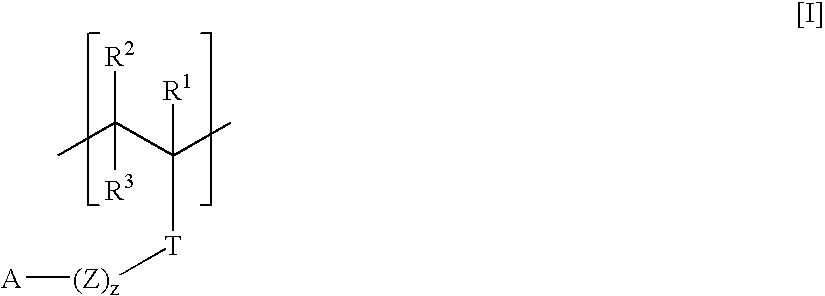Block polymers, compositions and methods of use for foams, laundry detergents, shower rinses and coagulants
a technology of block polymers and compositions, applied in the direction of ampholytes/electroneutral surface active compounds, seed immunisation, etc., can solve the problems of wasteful detergent use, consumer addition of additional detergent, and the efficacy of liquid detergents, etc., to prolong the suds volume and the effect of the duration
- Summary
- Abstract
- Description
- Claims
- Application Information
AI Technical Summary
Benefits of technology
Problems solved by technology
Method used
Image
Examples
synthesis examples
Example 1
[0671] Process for Making Poly(DNMAM-b-HEA)—Lithium diisopropylamide (5.6 mL, 11.12 mmol, 2.0 M), lithium chloride (2.35 g, 55.58 mmol) and THF (500 mL) are cooled to −78° C. 2-(Dimethylamino)ethyl methacrylate (25.16 g, 0.16 mol) is added to the solution and allowed to polymerize for 2 h. At this time, 2-hydroxyethyl methacrylate (62.47 g, 0.48 mol) is added to the reaction mixture. The reaction is stirred for an additional 2 h. The polymerization is quenched with methanol. Poly(DMAM-b-HEA) is isolated by removing the solvent by rotary evaporation.
example 2
[0672] Process for Making Poly(DMAM-b-HEA)—The procedure of Example 1 is repeated with the substitution of (diphenylmethyl)lithium for lithium diisopropylamide.
example 3
[0673] Process for Making Poly(DMAM-b-HEA-b-AA)-2-Hydroxyethylacrylate (125.00 g, 1.08 mol) is placed in a flask along to make a solution with anisole (250 mL). CuBr (41.6 mg, 29.0 mmol) complexed by 2,2′-bipyridyl (45.3 mg, 29.0 mmol) (catalyst) and methyl 2-bromopropionate (48.4 mg, 29.0 mmol) (initiator) are placed in the flask. The mixture is heated to 90° C. for 18 h. The product mixture is dissolved in THF and precipitated with methanol. The product is collected and added to a reactor to make a 50% solution with 1,2-dichlorobenzene. 2-(Dimethylamino)ethyl methacrylate (39.31 g, 0.25 mol) is added to the solution. CuCl (0.58 g, 58.0 mmol) complexed by hexamethyltriethylenetetramine (1.34 g, 58.0 mmol) is added to the reactor. The mixture is heated to 90° C. for 18 h. A polymer is isolated by dissolving the reaction mixture in THF and then precipitated with hexanes. The product is collected and added to a reactor to make a 50% solution with 1,2-dichlorobenzene. Acrylic acid (5.9...
PUM
| Property | Measurement | Unit |
|---|---|---|
| molecular weight | aaaaa | aaaaa |
| molecular weight | aaaaa | aaaaa |
| molecular weight | aaaaa | aaaaa |
Abstract
Description
Claims
Application Information
 Login to View More
Login to View More - R&D
- Intellectual Property
- Life Sciences
- Materials
- Tech Scout
- Unparalleled Data Quality
- Higher Quality Content
- 60% Fewer Hallucinations
Browse by: Latest US Patents, China's latest patents, Technical Efficacy Thesaurus, Application Domain, Technology Topic, Popular Technical Reports.
© 2025 PatSnap. All rights reserved.Legal|Privacy policy|Modern Slavery Act Transparency Statement|Sitemap|About US| Contact US: help@patsnap.com



